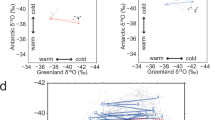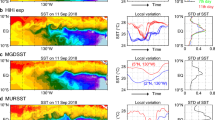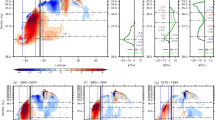Abstract
The oceanic thermohaline circulation (THC) carries light, warm surface water polewards and dense, cold deep water equator-wards, thereby transporting a large amount of heat towards the poles and significantly affecting high latitude climate. The THC has been remarkably stable, and its variability quite low, over the Holocene period (the past 10,000 years). The much greater climate instability and high-frequency variability recorded in ice1 and deep-sea31 cores throughout the preceding 150,000 years has been linked to greater THC variability2,3. Here we argue, using a global coupled ocean–atmosphere–ice general circulation model with realistic geography, that there is a wide range of weak mean states of the THC that cannot be stably sustained by the climate system. When the model THC is forced into a state in the unstable range, the THC may rapidly strengthen, collapse or display strong oscillations. The existence of this unstable regime may account for the greater variability of the THC and climate before the Holocene period.
This is a preview of subscription content, access via your institution
Access options
Subscribe to this journal
Receive 51 print issues and online access
$199.00 per year
only $3.90 per issue
Buy this article
- Purchase on Springer Link
- Instant access to full article PDF
Prices may be subject to local taxes which are calculated during checkout
Similar content being viewed by others
References
GRIP Members Climate instability during the last interglacial period recorded in the GRIP ice core. Nature 364, 203–207 (1993).
Broecker, W. S., Peteet, D. M. & Rind, D. Does the ocean-atmosphere system have more than one stable mode of operation? Nature 315, 21–25 (1985).
Boyle, E. A. & Keigwin, L. North Atlantic thermohaline circulation during the past 20,000 years linked to high-latitude surface temperature. Nature 330, 35–40 (1987).
Stommel, H. M. Thermohaline convection with two stable regimes of flow. Tellus XIII, 224–230 (1961).
McWilliams, J. C. Modelling the oceanic general circulation. Annu. Rev. Fluid. Mech. 28, 215–248 (1996).
Walin, G. The thermohaline circulation and the control of ice ages. Palaeogeogr. Palaeoclimatol. Palaeoecol. 50, 323–332 (1985).
Marotzke, J., Welander, P. & Willebrand, J. Instability and multiple steady states in a meridional-plane model of the thermohaline circulation. Tellus A 40, 162–172 (1988).
Mikolajewicz, U. & Maier-Reimer, E. Mixed boundary conditions in ocean general circulation models and their influence on the stability of the model's conveyor belt. J. Geophys. Res. 99, 22633–22644 (1994).
Brass, G. W., Southam, J. R. & Peterson, W. H. Warm saline bottom water in the ancient ocean. Nature 296, 620–623 (1982).
Toggweiler, J. R. et al. Reply. J. Phys. Oceanogr. 26, 1106–1110 (1996).
Bryan, F. High-latitude salinity effects and interhemispheric thermohaline circulations. Nature 323, 301–304 (1986).
Weaver, A. J., Sarachick, E. S. & Marotzke, J. Freshwater flux forcing of decadal and interdecadal oceanic variability. Nature 353, 836–838 (1991).
Chen, F. & Ghil, M. Interdecadal variability of the thermohaline circulation and high-latitude surface fluxes. J. Phys. Oceanogr. 25, 2547–2568 (1995).
Rahmstorf, S. Bifurcations of the Atlantic thermohaline circulation in response to changes in the hydrological cycle. Nature 378, 145–149 (1995).
Tziperman, E., Toggweiler, R., Feliks, Y. & Bryan, K. Instability of the thermohaline circulation with respect to mixed boundary conditions: Is it really a problem for realistic models? J. Phys. Oceanogr. 24, 217–232 (1994).
Zhang, S., Greatbatch, R. J. & Lin, C. A. A reexamination of the polar halocline catastrophe and implications for coupled ocean-atmosphere modeling. J. Phys. Oceanogr. 23, 287–299 (1993).
Rahmstorf, S. & Willebrand, J. The role of temperature feedback in stabilizing the thermohaline circulation. J. Phys. Oceanogr. 25, 787–805 (1995).
Manabe, S., Spelman, M. J. & Bryan, K. Transient response of a coupled ocean-atmosphere model to gradual changes of atmospheric CO2. Part I: Annual mean response. J. Clim. 4, 785–818 (1991).
Manabe, S. & Stouffer, R. J. Century-scale effects of increased atmospheric CO2 on the ocean-atmosphere system. Nature 364, 215–218 (1993).
Delworth, T., Manabe, S. & Stouffer, R. J. Interdecadal variations of the thermohaline circulation in a coupled ocean-atmosphere model. J. Clim. 6, 1993–2011 (1993).
Manabe, S. & Stouffer, R. J. Two stable equilibria of a coupled ocean-atmosphere model. J. Clim. 1, 841–866 (1988).
Rahmstorf, S. Climate drift in an ocean model coupled to a simple, perfectly matched atmosphere. Clim. Dynam. 11, 447–458 (1996).
Manabe, S. & Stouffer, R. J. Simulation of abrupt climate change induced by freshwater input to the North Atlantic ocean. Nature 378, 165–167 (1995).
Lenderink, G. & Haarsma, R. J. Variability and multiple equilibria of the thermohaline circulation associated with deep water formation. J. Phys. Oceanogr. 24, 1480–1493 (1994).
Griffies, S. & Tziperman, E. A linear thermohaline oscillator driven by stochastic atmospheric forcing. J. Clim. 8, 2440–2453 (1995).
Weaver, A. J. & Hughes, T. M. C. Rapid interglacial climate fluctuations driven by North Atlantic ocean circulation. Nature 367, 447–450 (1994).
Neelin, J. D. & Dijkstra, H. A. Ocean-atmosphere interaction and the tropical climatology. Part I: the dangers of flux adjustment. J. Clim. 8, 1325–1342 (1995).
Marotzke, J. & Stone, P. H. Atmospheric transports, the thermohaline circulation, and flux adjustments in a simple coupled model. j. Phys. Oceanogr. 25, 1350–1364 (1995).
Schiller, A., Mikolajewicz, U. & Voss, R. The stability of the thermohaline circulation in a coupled ocean-atmosphere general circulation model. Clim. Dynam. (in the press).
Yu, E.-F., Francois, R. & Bacon, M. P. Similar rates of modern and last-glacial ocean thermohaline circulation inferred from radio-chemical data. Nature 379, 689–694 (1996).
McManus, J. F. et al. High resolution climate records from the North Atlantic during the last interglacial. Nature 371, 326–329 (1995).
Author information
Authors and Affiliations
Rights and permissions
About this article
Cite this article
Tziperman, E. Inherently unstable climate behaviour due to weak thermohaline ocean circulation. Nature 386, 592–595 (1997). https://doi.org/10.1038/386592a0
Received:
Accepted:
Issue Date:
DOI: https://doi.org/10.1038/386592a0
This article is cited by
-
RETRACTED ARTICLE: Catastrophic flood outbursts in mid-continent left imprints in the Gulf of Mexico
Geo-Marine Letters (2023)
-
Bautin bifurcations in a forest-grassland ecosystem with human-environment interactions
Scientific Reports (2019)
-
The interaction between sea ice and salinity-dominated ocean circulation: implications for halocline stability and rapid changes of sea ice cover
Climate Dynamics (2016)
-
Hydrographic biases in global coupled climate models and their relation to the meridional overturning circulation
Climate Dynamics (2015)
-
Weak oceanic heat transport as a cause of the instability of glacial climates
Climate Dynamics (2010)
Comments
By submitting a comment you agree to abide by our Terms and Community Guidelines. If you find something abusive or that does not comply with our terms or guidelines please flag it as inappropriate.



